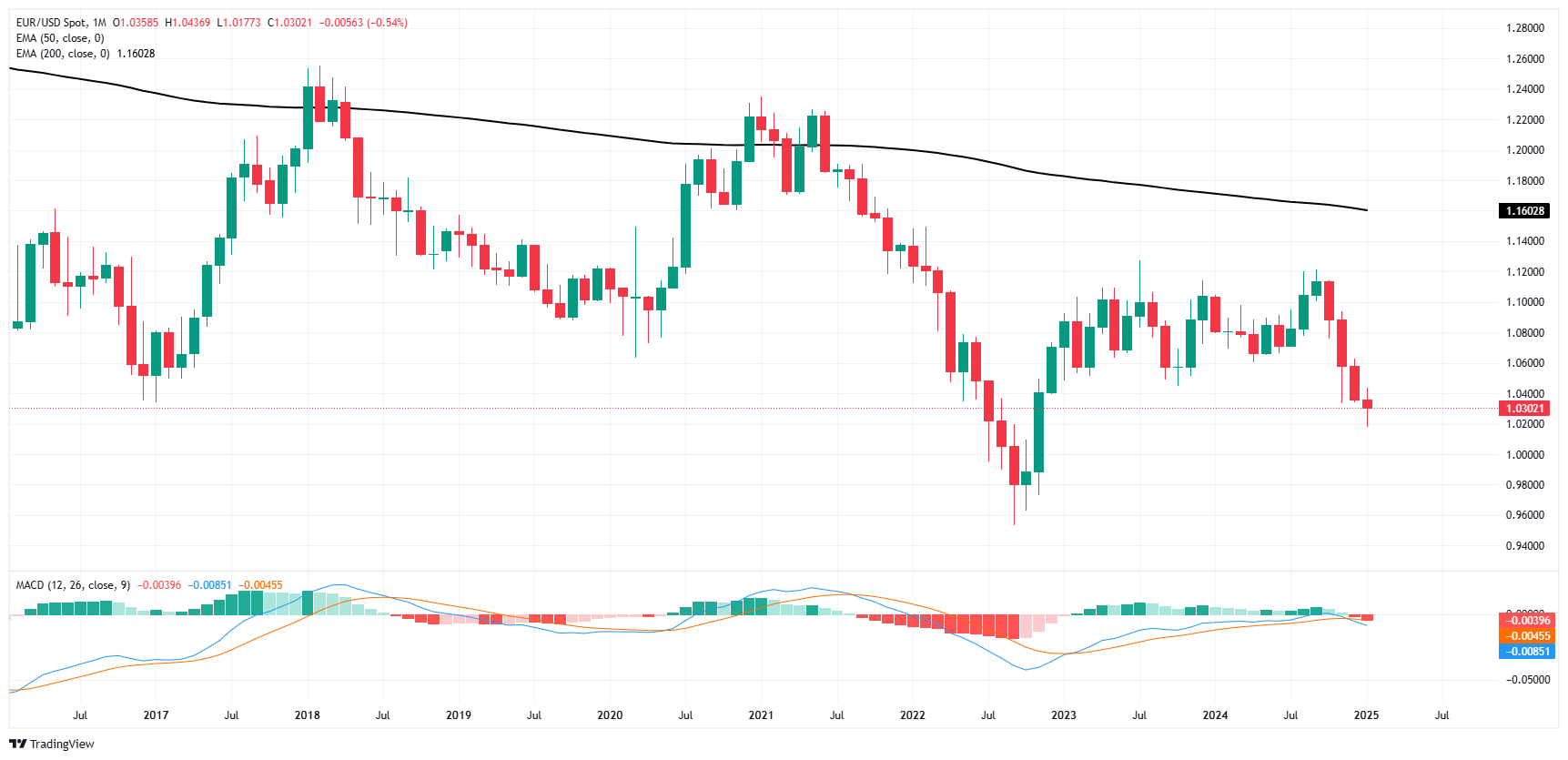- EUR/USD spun in a circle on Thursday, mired in the 1.0300 handle.
- Final German inflation figures hit the mark, pan-EU figures expected to do the same.
- US data is limited on Friday as Fiber traders gear down.
EUR/USD middled through Thursday’s market action with bids hung up on the 1.0300 price handle. There’s a limited offering from the economic data docket on Friday, and traders will be keeping an ear to the ground for any rumblings from central bank policymakers.
German Harmonized Index of Consumer Prices (HICP) inflation figures came in exactly as markets expected on Thursday, not exactly a large reach as they were non-preliminary figures and rarely change unless things are going disastrously wrong. Retail Sales figures moderated in December, easing back to 0.4% MoM in the headline figure. Markets expected a tick down to 0.6% from the previous month’s revised 0.8%. Core Retail Sales excluding automotive expenditures rose to 0.4% MoM from 0.2%, meeting median analyst forecasts. The mixed figures failed to spark significant changes in investor sentiment in either direction.
Coming up on Friday, little of note sits on the data docket, with more non-preliminary HICP inflation figures due for the broader pan-European economic zone, which is expected to confirm a slight uptick to 2.8% YoY from 2.7%. On the US side of the Atlantic, US Housing Starts, Building Permits, and Industrial Production figures for December are all expected to print relatively close to previous figures, and are unlikely to drive much market volatility on their own.
EUR/USD price forecast
Fiber has extended into a two-day flat spin, with bids getting stuck in the mud at the 1.0300 technical handle. Price action has moderated after last week’s test of the 1.0200 handle, chalking in a fresh 26-month low in the process. Bullish recovery attempts have thus far failed to materialize in a meaningful way, though EUR/USD is slowly crawling its way back from what is otherwise shaping up to be a fourth straight calendar month of declines in the FX market’s most-traded pair.
EUR/USD daily chart
Euro FAQs
What is the Euro?
The Euro is the currency for the 19 European Union countries that belong to the Eurozone. It is the second most heavily traded currency in the world behind the US Dollar. In 2022, it accounted for 31% of all foreign exchange transactions, with an average daily turnover of over $2.2 trillion a day. EUR/USD is the most heavily traded currency pair in the world, accounting for an estimated 30% off all transactions, followed by EUR/JPY (4%), EUR/GBP (3%) and EUR/AUD (2%).
What is the ECB and how does it impact the Euro?
The European Central Bank (ECB) in Frankfurt, Germany, is the reserve bank for the Eurozone. The ECB sets interest rates and manages monetary policy. The ECB’s primary mandate is to maintain price stability, which means either controlling inflation or stimulating growth. Its primary tool is the raising or lowering of interest rates. Relatively high interest rates – or the expectation of higher rates – will usually benefit the Euro and vice versa. The ECB Governing Council makes monetary policy decisions at meetings held eight times a year. Decisions are made by heads of the Eurozone national banks and six permanent members, including the President of the ECB, Christine Lagarde.
How does inflation data impact the value of the Euro?
Eurozone inflation data, measured by the Harmonized Index of Consumer Prices (HICP), is an important econometric for the Euro. If inflation rises more than expected, especially if above the ECB’s 2% target, it obliges the ECB to raise interest rates to bring it back under control. Relatively high interest rates compared to its counterparts will usually benefit the Euro, as it makes the region more attractive as a place for global investors to park their money.
How does economic data influence the value of the Euro?
Data releases gauge the health of the economy and can impact on the Euro. Indicators such as GDP, Manufacturing and Services PMIs, employment, and consumer sentiment surveys can all influence the direction of the single currency. A strong economy is good for the Euro. Not only does it attract more foreign investment but it may encourage the ECB to put up interest rates, which will directly strengthen the Euro. Otherwise, if economic data is weak, the Euro is likely to fall. Economic data for the four largest economies in the euro area (Germany, France, Italy and Spain) are especially significant, as they account for 75% of the Eurozone’s economy.
How does the Trade Balance impact the Euro?
Another significant data release for the Euro is the Trade Balance. This indicator measures the difference between what a country earns from its exports and what it spends on imports over a given period. If a country produces highly sought after exports then its currency will gain in value purely from the extra demand created from foreign buyers seeking to purchase these goods. Therefore, a positive net Trade Balance strengthens a currency and vice versa for a negative balance.






